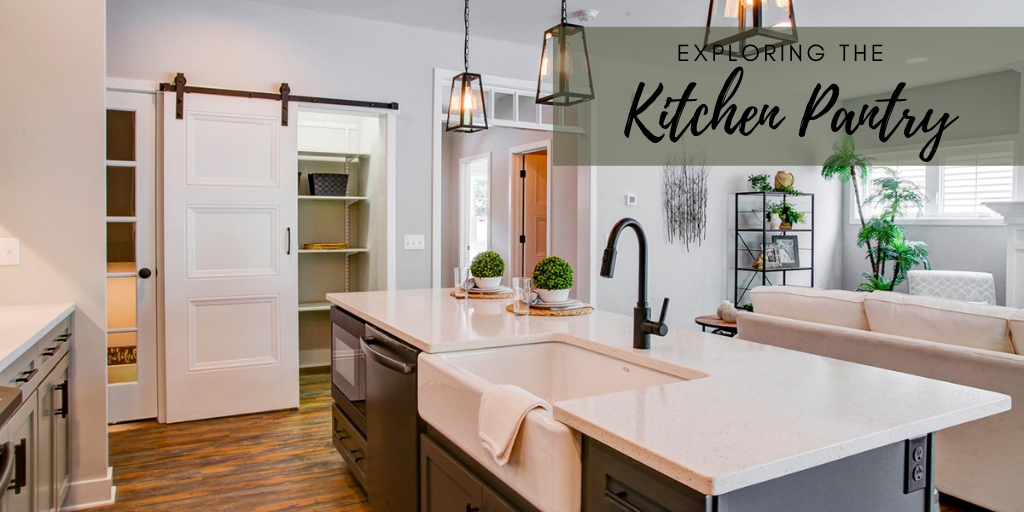
Exploring the Spacious Kitchen Pantry
November 20, 2019
The kitchen pantry: This once hidden, forgotten space now plays a significant role in today’s kitchen design and functionality. Pantries come in all shapes and sizes — from small closets with just a few shelves to large, complimentary rooms that house floor-to-ceiling shelves, countertops and cupboards.
A Brief History of the Pantry
The word pantry comes from the Old French term paneterie, which derives from the word pain — the French word for bread.
Beginning in the late Middle Ages (1250-1500 AD), households created specific places to store food. The larder was designed to keep items cold even in the hottest weather. It often had slate or marble shelves several inches thick where fish, meat and other items were placed and covered with muslin cloth. The pantry was where bread was stored and food preparation took place. Over time, it evolved into a separate space (room or hallway) located between the kitchen and formal dining room.
In the late 19th century, a furniture company based in New Castle, Indiana, began manufacturing the Hoosier cabinet, which was no ordinary cabinet. In addition to storing staples like flour, sugar and spices, it also had space for small kitchen tools such as the flour sifter and meat grinder. With its big storage capacity and workable counter, it became an essential in American kitchens and remained popular until the 1940s.
The Modern Kitchen Pantry
Today, the pantry still takes on a variety of shapes and sizes, depending on your kitchen layout, but when considering remodeling, there are typically two types of kitchen pantries homeowners consider: the walk-in and the cabinet. Let’s take a look at each.
The Walk-In Pantry
With its separate space and multitude of storage options, the walk-in pantry (and its big brother, the butler’s pantry) is only growing in popularity.
Pros:
- More storage. With floor-to-ceiling shelving, a walk-in pantry gives you plenty of room to store ingredients, cookbooks, large kitchen appliances, canning supplies and more.
- Better organization. Walk-in pantries allow the Marie Kondo side of you to come out and become more organized. The larger shelves allow for categorizing ingredients more effectively than a cabinet pantry would.
- Removes clutter from countertops. Many of the small kitchen appliances that you don’t use every day, such as a toaster, air fryer, InstaPot or KitchenAid mixer, can be removed from the countertop and stored in the walk-in pantry. Some families have even added a charging station into their pantry design to eliminate the mobile device cord-clutter that often occurs in the kitchen. This all equates to a cleaner-looking kitchen and more counter space for food prep when you need it.
Cons:
- Spread-out storage. More storage isn’t always better. Because the storage is separated from the food prep area and not at your fingertips, it will take you more time to gather the ingredients and bring them into the kitchen.
- Requires more upkeep. A bigger space means more upkeep, which includes more shelves to wipe down and declutter and more floor to mop.
- Uses valuable square footage. The biggest disadvantage with a walk-in pantry is that it takes up valuable real estate that could be used towards maximizing your kitchen space.
The Cabinet Pantry
Cabinet pantries are ideal for any size kitchen, and today’s cabinet manufacturers offer a wide variety of options for customization to fit your exact needs and space.
Pros:
- Less square footage. The cabinet pantry does not take up nearly the square footage as a walk-in pantry. This means that you’ll have more space for other items, such as seating, food prep or cooking. Others have added the saved square footage to other adjacent areas, such as a mudroom, small office or first-floor master suite.
- More accessible. During food preparation, it is much more convenient to have your ingredients located where you cook. With rollouts and other fun and functional cabinetry options, it’s easy to design a series of cabinets to keep items at your fingertips.
- Perfectly centralized. Snacks, ingredients, small appliances and more — a kitchen cabinet pantry can store everything in one, centralized location. This means you spend less time searching across several walls of shelves for the item you are looking for.
Cons:
- Lost counter space. You’ll gain more square footage, but you will sacrifice countertop space.
- Added cabinet expense. Cabinetry is one of the more expensive kitchen components, and with all of its customizable functionality, the pantry cabinet will be one of the more expensive cabinets you select.
- Limited storage space. The smaller size (compared to the walk-in) does limit the storage space, especially for portable kitchen appliances, such as an air fryer, KitchenAid mixer or bread machine.
Both the walk-in pantry and cabinet pantry are excellent options, and each solution works, so it really comes down to two things: the square footage available and how you want your kitchen to function.
As you think about how best to integrate a pantry into your remodeled kitchen, it’s important to navigate the delicate balance between storage and performance. We, as professionals, can help guide your decision-making process so that you make the choices you’ll be happy with for years to come. Contact us.